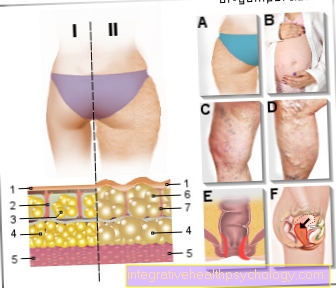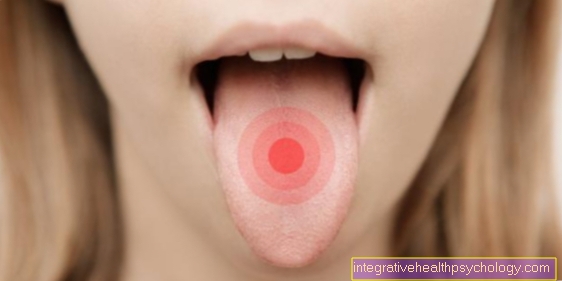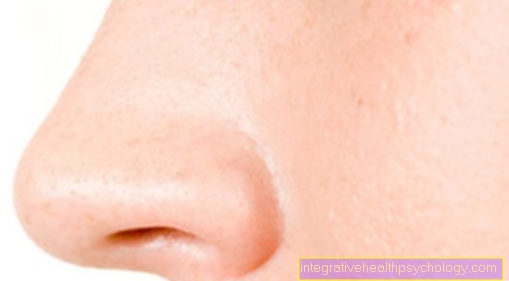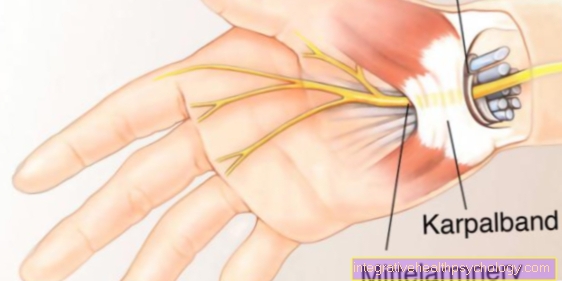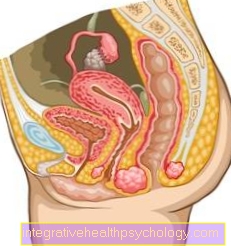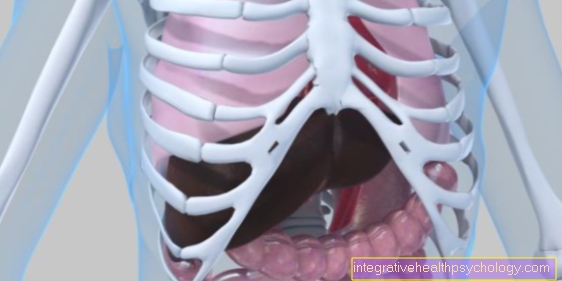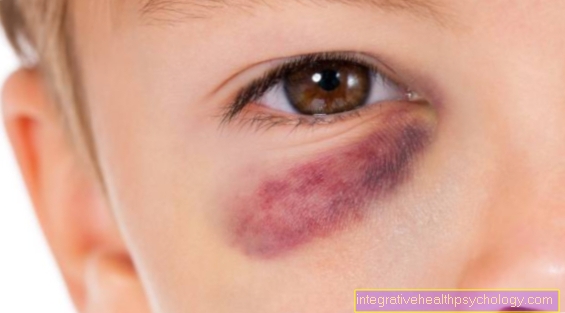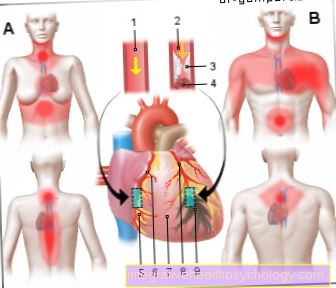Emla cream
What is Emla Creme?
Emla Creme is a local anesthetic, i.e. a means for the local suppression of pain. For example, it is used on the skin before certain medical procedures. Emla Creme contains the active ingredients lidocaine and prilocaine. Both active ingredients have a numbing effect on nerves. This should result in a local insensitivity, i.e. limited to the area of application, after the application of Emla Creme.
Read more about the main article: Local anesthesia
interaction
In particular, Emla Creme can interact with other medicinal products with a similar effect. This mainly includes other local anesthetics. Emla Creme may also increase the undesirable effects of such a drug. The same applies to medicines that can have an effect on the metabolism of the active ingredients contained in Emla Creme. These include, for example, some beta blockers. Even if Emla Creme is normally well tolerated due to its local mode of action, you should therefore consult a specialist in case of doubt. If in doubt, a doctor or pharmacist should always be consulted.

application areas
Emla Creme can be used for local anesthesia of the skin before minor medical interventions, such as a blood sample. It can also be applied to pain relief before surgical operations that only affect the surface of the skin. Even the sensitive mucous membrane of the genital area can be anesthetized in this way before such an operation, as long as the operation is limited to the surface of the mucous membrane. In the genital area, the cream is also used to numb the skin before another local anesthetic is injected into deeper layers.
Tattoo
Because of its pain relieving effect, Emla Creme is sometimes recommended for tattooing. However, Emla Creme was not developed for this use or was not intended by the manufacturer. There is also criticism that the cream can cause the skin to swell and thus the quality of the tattoo is impaired. Particular care should be taken that nothing speaks against the use of the cream or that it may not be given for medical reasons. This is the case, for example, if there is hypersensitivity to one of the ingredients.
Read more on the topic: Tattooing pain
Active ingredient and effect
There are typically two active ingredients in Emla Creme: lidocaine and prilocaine. Both active ingredients are very similar in their effects. They prevent the transmission of nerve signals. Signals travel in nerves as waves of electrical excitation. Nerves have special ion channels for this transmission. Lidocaine and prilocaine inhibit these ion channels. Since these ion channels are crucial for the transmission of a nerve signal, the nerves are no longer able to transmit signals. Without the transmission of signals from the sensory cells of the skin, the sensation in the corresponding region is impaired. This is perceived as numb. The active ingredients reach thin nerve endings more easily than thicker ones. This causes the skin's small nerve endings to fall out first. These are especially important for gross sensations such as pain or temperature.
Read more on the topic: Lidocaine
side effect
Lidocaine and prilocaine, which are contained in Emla cream, mainly cause side effects when they get into the bloodstream.
Other possible undesirable effects are, above all, local skin reactions. These include, for example, reddening or peeling of the smeared skin. It is also possible that the affected skin area swells after application. This is an increase in tissue water called edema. A slight burning sensation or itching at the beginning of treatment has also been observed.
The prilocaine in Emla Creme can cause what is known as methhemoglobinemia. This leads to changes in the red blood pigment, also called hemoglobin. This can no longer efficiently deliver oxygen to the tissue. Young children in particular are unable to effectively convert methhemoglobin into normal hemoglobin. Symptoms of methhemoglobinemia are blue lips, restlessness, and unspecific symptoms such as dizziness or headaches.
Read more on the topic: Side effects of local anesthetics
When should Emla Creme not be used?
Emla Creme should not be used if you are hypersensitive to any of the substances it contains. In addition to the active ingredients it contains, there are other ingredients that are supposed to give the cream its consistency. Hypersensitivity to these can also exist. Since the active ingredients are chemically very similar to other local anesthetics, caution is advised even if you are known to be sensitive to a related active ingredient. In addition, it is not recommended for use in the ear canal, especially if the eardrum is damaged. Caution should also be exercised in other areas of the body, such as the eyes. As always, a doctor or pharmacist should be consulted in case of doubt.
dosage
The dosage and exact technique for applying Emla Creme also depends on the area to be anesthetized. Normally, a thick layer of cream is spread over the area to be numbed. The cream is then covered with a plaster. Now you have to wait more than an hour so that the cream can develop its full effect. For certain interventions, the waiting time can be shorter. Then the plaster is removed. The amount of cream applied depends primarily on the size of the area. In general, about 1 to 2 grams should be distributed over 10 cm2 of skin.
Also read the article: The Emla patch.
Use in children
In principle, Emla Creme can also be used on children. In children over twelve years of age, the application hardly differs from that in adults. The same dose is recommended for both age groups. Younger children should receive a reduced dose. The reason for use is often different in children under twelve years of age. Here Emla Creme is mainly used to reduce pain before taking blood or placing cannulas. As in adults, Emla Creme is also used to ensure local anesthesia before minor surgical procedures on the skin. The exact dose is staggered. While in children between six and eleven years of age up to 20 grams may be distributed over ten square centimeters, infants up to two months old should not receive more than one gram on the same area. In between there are further gradations.
Use in the genital area
Emla Creme is also used medically in the genital area. It is used for local anesthesia of the genital mucous membrane, so that an operation on the surface of the skin is less painful, or local anesthesia can be performed by syringe. First the skin surface is anesthetized and then another local anesthetic is injected into the tissue under the anesthetized skin. This means that larger interventions can be carried out under local anesthesia, since deeper layers are also anesthetized by the injected drug.
Alternatives to Emla Creme
The active ingredients lidocaine and prilocaine contained in Emla Creme are also represented as a combination in other products. Since these are generic, the price is often lower.Generics are drugs that have the same composition as a trademarked drug such as Emla Creme, but are usually sold cheaper. In addition to generics, there are also various creams that are not identical in composition to Emla Creme, but are similar in effect.
Read more on the topic: Lidocaine ointment
Is the Emla cream available without a prescription?
Emla Creme is not a prescription drug. This means that it can also be purchased without a prescription. However, Emla Creme may only be sold in a pharmacy, so Emla Creme is pharmacy-only. Emla Creme should also only be used according to the intended indication.
costs
Emla Creme is often sold in 30 gram packs. These usually cost between 25 and 40 euros. 39.38 euros is often given as the RRP or AVP. The AVP is the price that a pharmacy can charge the statutory health insurance companies for a drug. Smaller packs are of course correspondingly cheaper. For example, 5 gram packs are also sold. These usually cost between 6 and 10 euros. There are also packs that contain 5 times 5 grams, for a total of 25 grams.


